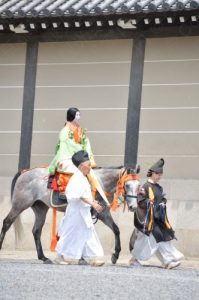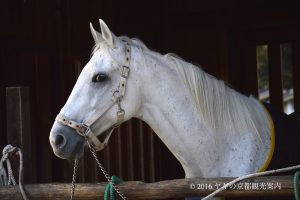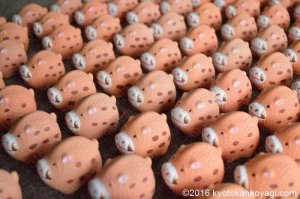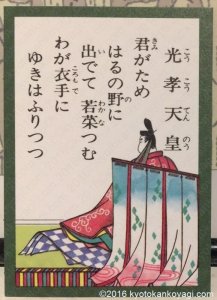Overview on Hakuba Soran Shinji
- Hakuba Soran Shinji is a Shinto ritual held at Kamigamo Jinja shrine in Kyoto on January 7th.
- Without Shinme horse, we are not able to held the ritual. In Kyoto, only Kamigamo Jinja shrine keeps it.
- On the day, Japanese people eat Nanakusagayu Okayu rice bowl.
- Nanakusagayu has seven leaf vegetables good for our health. An ancient Chinese and Japanese customs gave birth to it.
2026年/令和八年最新
I’ll eat beans on 1/7/2025
What is Hakuba Soran Shinji? 白馬奏覧神事とは?
Hakuba Soran Shinji is a Shinto ritual 白馬奏覧神事は神事
Hakuba Soran Shinji is an annual ritual helld in Jan. 7th at Kamigamo Jinja shrine (上賀茂神社) in Kyoto. In ancient times, Aouma Sechie (白馬節会) used to be held in the imperial court. It based on an ancient Chinese story: A glimpse of a white horse in January get rid of evil spirits. In Wu Xing a.k.a. Five elements philosophy, in which every phenomena is explained by five elements: Wood, fire, earth, metal, and water, spring is “Seiyo (青陽),” and horse is an animal of “Yo (陽).” Ancient Chinese people found Seiyo and Yo and began to see horse in Spring (In ancient lunar calendar, spring starts in January. )
Aouma Sechie was a party held by the emperor at Shisinden hall (the building in the photos above). On January 7th, he and participants saw a horse to eliminate them to welcome a new year. The word Aouma (白馬) means “Blue horse.” though it means “White horse” in Kanji. (“白馬” reads “Hakuba” these days.)
As Ohotomo no Yakamochi, a famous poet and military officer in the 8th century, described in Manyosyu, the word “blue horse” didn’t mean a blue horse actually but it meant a gray horse (See the photo above). In Japan, it is believed that something white is able to remove evil things. I suspect this idea replaced gray horse with white one and the sound of “Ao” remained.
The Sechie was gradually accepted outside of the imperial court and became a ritual of Shinto shrine. Hakuba Soran Shinji (it sometimes called “Hakuba/Aouma Shinji”) cannot take place without horse. Shinto shrine used to keep Shinme horses (神馬) but only a few Shinto shrine keeps horse these days. In Kyoto, only Kamigamo Jinja shrine keeps it.
The aim of the ritual is to let Kamo Wake Ikazuchi no Kami (賀茂別雷命), the Deity enshrinedn and worshiped at Kamigamo Jinja shrine see a horse and to take anything evil away from us and a new year. (“Kamogamo shrine is a de facto name of Kamo Kamo Wake Ikazuchi Jinja shrine)
What is Shinme horse? 神馬とは?
Shinme is a horse dedicated to Shinto Deity. A long time ago, it is believed that people started to dedicate Shinme horse to Kifune Jinja shrine (貴船神社). When they wanted a sunny day, they dedicated a white horse. On the other hand, they wanted a rainy day, they dedicated a black horse.
To keep horse must have been a burden for dedicator and shrine and horse was replaced with Ema (絵馬). Ema literary means “Picture of horse” and actually means the wooden pentagon plate in the photo. (A boar is painted but it is an “Ema.”)
As I described before, only Kamigamo jinja shrine keeps Shimme horse. His name is “Koyamago (神山号)”, named after the Mt. Koyama.
Koyama (神山) is a Goshintai. Gosintai (御神体) is an object to which Shinto Deity descend. There are small sand mountains in Kamigamo jinjya shrine. They stand for Koyama.
We are able to see him every week-end and special occasions.
Hakuba Soran Sinji 白馬奏覧神事
Pray for the emperor Showa 昭和天皇遥拝式
30 years ago, emperor Showa passed away on January 7th. So, a ritual called “Showa Tenno Yohaishiki” is held around 10 p.m. In this ritual, we pray for former His Imperial Majesty facing toward the his tomb.
Hakuba Soran Shinji 白馬奏覧神事
Koyamago is ready in a robe which crests of Kamigamo jinja shrine are woven.
Around 10:20, he departs Shinmesya, his place, to the main hall along the red line in the map.
The blue alien is a gate to the main hall. We are not able to enter it by way of this gate usually.
He is in front of the main hall. In front of a corridor located in front of the main hall precisely. Kamigamo Jinja shrine is so sacred place that only the emperor could be in front of the main hall. On the corridor, there is a priestess. She gave him soy beans. It is believed that soy bean terminate evil spirits. See the video!
Hikiuma no gi 牽馬の儀 2019
At 12:00, 13:00, and 14:00 a.m., he walks around the area of Kamigamo Jinja shrine. His stroll is called Hikiuma no gi.
Jinjitsu no Sekku and Nanakusa gayu bowl 人日の節句と厄除七草粥
Sekku and Nanakusa Gayu 節句と七草粥
January 7th is Jinjitsu no Sekku (人日の節句). Jinjitsu no Sekku is one of Five Sekku and based on an ancient Chinese custom. Sekku is a kind of turning point of each season. On the day, we eat Nanakusa Gayu rice bowl (七草粥). The custum and Nanakusa Gayu is based on an ancient Chinese and Japanese customs.
What is Jinjitsu no Sekku 人日の節句
In the days of old, Chinese people counted first seven days as animal.
1st: Rooster
2nd: Dog
3rd: Boar
4th: Sheep
5th:Ox
6th: Horse
7th: Human
8th: Grain
Each day, fortune-tellers read the future. On the 8th day, they read prospect of a year. After the fortune telling, people ate “Nanasu no Saikan (七種菜羹)” soup. This custom was introduced in Japan from ancient China.
Wakanatsumi 若菜摘み
Wakanatsumi is an ancient Japanes custom. People had Wakanatsumi, a custom picking Wakana covered in snow. Nanakusa meams so-called “Seven leaf vegetable in spring.”
Wakanatsumi is a populara custom in spring. Emperor Koko composed a Waka poem about it in Hyakunin Issyu, a famous composition of Waka. People ate these vegetable for the purpose of taking vitality of the nature to avoid evil spirits.
Seven leaf vegetables 七草の意味
Each vegetable has euphony and effects on us.
Seri セリ
Euphony: To win
Effects: It gives us good appetite and health for function of intestine.
Nazuna ナズナ(所謂ぺんぺん草)
Euphony: To clean something
Effects: It prevents us from high blood pressure and reduces fever.
Gogyo ゴギョウ
Euphony: Katashiro. Katashiro is a substitute for us. It wears evilness on behalf of us.
Effects: It prevents us from high blood pressure and reduces fever.
Hakobera ハコベラ
Euphony: Prosperity.
Effects: It gives us health for function of intestine.
ホトケノザ
Euphony: Pedestal of a statue of Buddha.
Effects: It gives us health for function of intestine.
Suzuna スズナ
Euphony: A ring invites Deity.
Effects: It gives us health for function of intestine.
Suzushiro スズシロ
Euphony: Purity.
Effects: It gives us health for function of intestine.
Nanakusa Gayu 七草粥
The fusion of Jinjitsu no Sekku and Wakanatsumi gave birth to a custom to eat Nanakusagayu bowl. At Kamigamo Jinja shrine, we have it for 500 yen.
How to get to Kamigamo shrine?
From JR Kyoto station
Take subway Karasuma line and get off at Kitaoji station. From Kitaoji bus terminal adjacent to Kitaoji station, take the bus no. 37 and get off at Kamigamo misonobashi bas stop.
About Kamigamo shrine
ヤギの京都観光案内/KYOTO GOAT BLOGをもっと見る
購読すると最新の投稿がメールで送信されます。






























